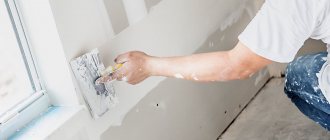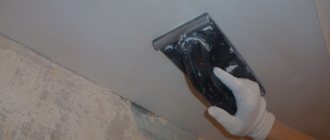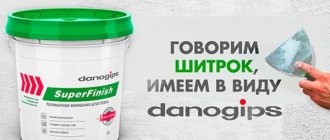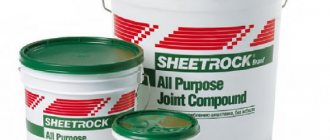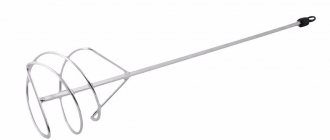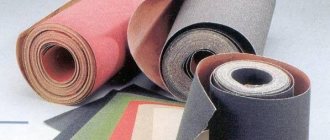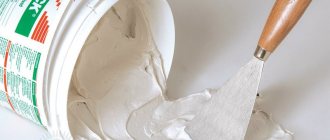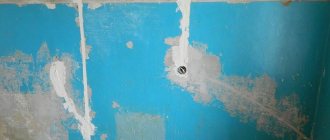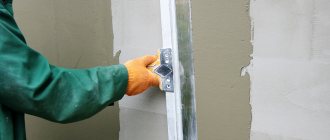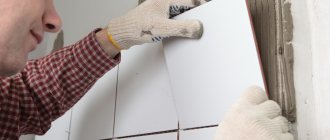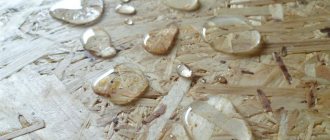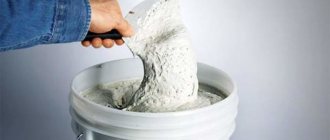It is impossible to carry out decorative finishing and prepare walls for further work without putty. These compositions may differ from each other in grain size, form of implementation and some other parameters. Such a variety of putties was created so that in each specific case it would be possible to select the most suitable material. For example, different mixtures will be needed for external and internal work.
According to their purpose, putties are divided into:
- universal;
- finishing;
- starting ones.
The latter have a high grain size, have good adhesion and excellent strength. They are used to level walls with differences of up to 15 mm. The finishing putty is applied after the starting putty. It is used for final cladding before decorative finishing. Such compositions have a smaller grain size, so they allow you to create a perfectly smooth and even surface.
Peculiarities
The most important feature of Sheetrock putty is its versatility. It can be used both for finishing and for decoration if it contains, for example, marble chips or vinyl filler.
Craftsmen appreciate this mixture for its long service life. The polymers contained in the finished mixture make the material reliable and protect the putty from cracking.
This brand of putty can be purchased ready-made or you can buy a dry mixture to prepare the solution yourself. The difference will be in price (the first option is more expensive) and in the shelf life of the product (it is longer for the dry mixture).
To work with ready-made Sheetrock putty, no special skills are required. The range of applications of putty is unlimited only by leveling walls. It is also excellent for sealing seams and cracks.
The ready-made mixture can also save the master’s time, which would have been spent on kneading the dry mixture, which helps reduce finishing time.
The next important feature of this putty is the drying speed of the material and the conditions under which it can be worked. Depending on the thickness of the layer and the temperature in the room, the drying time of the material will be from three to five hours. After which the walls are sanded. This putty can be used in rooms with high humidity. The quality of the coating will be achieved by the high degree of adhesion of the putty.
One of the advantages of Sheetrock products is its resistance to cold. This brand of putty can withstand up to ten cycles of freezing and thawing, provided the mixture is defrosted only at room temperature.
The versatility of using putty adds to its advantages. It is used to level walls for painting, and it is also perfect for any type of wallpaper.
The advantage of the Sheetrock ready-mix will also be the material from which it is made. Its environmental friendliness will allow for renovations in children's rooms and medical institutions.
Sheetrock, Knauf “Rotband paste” or Vetonit LR - which is better
The materials listed are the most popular among finishers. But there are features that must be taken into account when choosing. Thus, Shitrok creates the smoothest surface even without sanding. After sanding, it must be primed, but without sanding this step can be skipped. Shitrok is ideal for painting, the most durable.
Primer must be applied on top of Vetonit; this material is best suited for subsequent wallpapering. The disadvantage of Vetonit in comparison with Shitrok is less plasticity, but the color is perfectly white. Another disadvantage of Vetonit is the need for dilution, while Shitrok is a ready-made mass.
When comparing Shitrock and “Rotband paste” from Knauf, the following should be noted. There are few differences in the recipe; Knauf also makes high-quality material with small marble particles and a polymer matrix. The surface after finishing coating from Knauf remains perfectly smooth; it does not need to be polished or sanded. Typically, “Rotband paste” is purchased if a thicker layer is planned to seal wall defects. Shitrok involves thin application - up to 2 millimeters. You should select the material based on your needs - then the quality of the work will not cause any complaints.
Kinds
Sheetrock putty is available in three versions, each of which has its own range of applications.
Their description:
- Sheetrock Fill Finish Light. This type of mixture is characterized by maximum strength. This is especially important when a thin layer needs to be applied. It is mainly used for restoration. It is also beautiful in tandem with drywall.
- "Sheetrock Superfinish" (Danogips). From the name itself, the purpose of the putty is clear - finishing. It is characterized by minimal shrinkage and is not used for sealing seams.
- “Sheetrock All Purpose.” A universal option. Suitable for sealing joints in brickwork, as well as for texturing, creating patterns and decorating walls. The only factor in which it is not recommended to use this particular option is high humidity in the room.
In the room where finishing is done with any Sheetrock putties, the temperature should not be lower than 13 degrees. Both the first and subsequent layers are applied strictly to a dry surface.
The technology for creating cosmetics for wall decoration Sheetrock is constantly being improved, meeting the most stringent requirements and needs of the client.
Description of material
Shitrok putty is a composition based on limestone or dolomite with the inclusion of vinyl polymers and other additives that impart unique properties. It has a homogeneous creamy consistency. The mixture is completely ready for use; only preliminary stirring is required. In some cases, you can dilute the putty with water to obtain a more liquid consistency.
Sheetrock putty
The putty is easily applied to surfaces, forming a perfectly flat surface. Used in the following cases:
- for leveling various surfaces: ceilings, walls, slopes, etc.;
- for sealing cracks in brickwork, concrete base or plaster;
- for sealing seams between plasterboard sheets;
- for finishing corners;
- for applying the first or finishing layer;
- for lamination and texturing of various planes.
The technical characteristics of the building material are as follows:
- color white or cream;
- density is 1.65 kg/l;
- drying time of the composition is 5 hours;
- shelf life in a closed container is several months;
- applied manually or mechanically;
- applied at a temperature not lower than +13 degrees;
- Available in 3.5 and 17 liter buckets.
Sheetrock putties have a number of advantages. These include:
- Easy to apply. The composition has a consistency that makes it easy to apply the material to surfaces. Excellent adhesion simplifies the work process.
- The composition is completely ready for use, which saves time on preparation and eliminates the risk of mixing the mixture in the wrong ratio.
- Long drying time for the composition. The remaining putty can be covered with a lid and stored for several months.
- Economical consumption. Due to its special oily consistency, the composition is easy to apply and the number of falling drops is minimized.
- Low shrinkage, which guarantees a high-quality finish without further damage or cracking.
- Compatibility with various materials and substances, which allows you to apply putty on various surfaces (concrete, brick, plasterboard) and subsequently finish them with any materials (wallpaper, paints, plasters, etc.).
- Durability. The shelf life is 12 months. If the bucket of putty has already been opened and the composition has been used, then the material can be stored for several months.
- High quality of finished surfaces.
- Affordable prices.
Specifications
Undoubtedly, Sheetrock lightweight polymer putty is one of the leaders in the finishing materials market.
The finished putty mixture of this brand is distinguished by the following technical characteristics:
- Convenient packaging. The volume of containers in which the finished mixture is produced varies from 3.5 to 28 liters, which allows you to select the required quantity individually for each finishing object. There are purchasing options for 7, 17, 18, 20 liters.
- Material color. The color of the putty in the container will be white. After drying on the surface, it acquires a pleasant ivory shade.
- Drying time of the material. Sheetrock putty mixture dries quickly - from three to five hours. This drying is influenced by the factors discussed above.
- The putty density is 1.65 kg/l.
- The vinyl included in the mixture allows it to treat any surface (the composition also includes talc powder, limestone and attapulgite).
- The mixture can be stored for up to one year and used more than once.
Compound
Sheetrock putty is popular not only among builders, but also among people doing repairs themselves.
The solution is sold in plastic containers of various sizes. You can buy a bucket with a volume of 17 l and 3.5 l, respectively, 28 kg and 5 kg. The finishing solution includes:
- Dolomite or limestone.
- Ethyl vinyl acetate (vinyl acetate polymer).
- Attapulgite.
- Talc or pyrophyllite is a component containing silicon.
- Cellulose microfiber is a complex and expensive component that allows the solution to be used on glass surfaces.
- Antifungal components and other antiseptics.
How to choose?
The choice of ready-made putty mixture depends on the purpose of its use (full finishing of walls and ceilings, caulking of joints, decor). And if you choose between latex or acrylic putty, then the first option will definitely give a head start to the second. Latex, unlike acrylic, is able to give the putty mixture the required thickness and create the necessary strength of the coating. Sheetrock mixture will be an excellent assistant in leveling walls and ceilings, covering seams and cracks, as well as in various decorative solutions.
Numerous experiments carried out with this material have proven its quality, durability and versatility. And the quality certificate confirms this.
Consumption
Sometimes it is difficult to decide on the right amount of material needed. Basically, such difficulties are faced by people who are not engaged in professional finishing, but by amateurs who decide to renovate their home themselves.
As for the consumption of the Sheetrock putty mixture, it is quite economical and amounts to approximately 1 kg of material per 1 square meter of room, if finishing on drywall, and 0.51 kg/p. m per 1 m² when applying gypsum board sheets to the joint. It is worth considering the degree of readiness of the surface for applying the putty mixture. If the wall is uneven and has many flaws, then a little more material may be needed. If this is, for example, an ideal sheet of drywall, then the material consumption may be less than specified.
Application Tips
The process of working with Sheetrock ready-mix is quite simple. Tools that will be useful to apply the mixture to the surface are a spatula, joint tape (you can use “Sheetrock Joint Tape”), sandpaper and a sponge.
First of all, the walls are prepared: the old material is removed, the seams are sealed with tape, the surface is leveled, sanded, and degreased. These manipulations are mandatory before applying the putty. There should be no imperfections on the surface. The contents of the freshly opened bucket of putty mixture are mixed.
Place a small amount of Sheetrock putty on a wide spatula and apply the first layer using a stretching motion from ceiling to floor. It is important to know that it is applied strictly to a dry layer of plaster. A poorly dried surface can lead to mold growth in the future.
Leave the first layer until completely dry (at least 3-5 hours). Only after this can you begin to apply the second one. To achieve maximum smoothness of the surface, many craftsmen recommend sanding it after each layer of putty with an abrasive mesh. A grit size between 180 and 240 is best. There can be from two to five layers. After all the work done, the surface contaminated with dust is cleaned.
If desired, you can add a small amount of water to the finished mixture. But you shouldn’t get carried away with this. Water is added little by little and the whole mixture is thoroughly mixed. Too much water can lead to changes in the properties of the putty, which will further affect the quality of work and durability of the material. Mixing Sheetrock putty mixture with other materials is strictly prohibited.
If suddenly the putty was frozen, then it is necessary to defrost it at room temperature, then stir the contents of the bucket until the consistency is uniform and all bubbles disappear. All mixture remaining after work is tightly closed with a lid and stored at room temperature.
Sheetrock putty has long established itself on the market and has many positive reviews. The putty can be used by both an experienced craftsman and an amateur who wants to make an easy but reliable repair.
Craftsmen who have already tried the ready-made Sheetrock putty mixture give preference only to it.
In the next video you will find a review of Sheetrock finishing putty.
Dry mixture or ready-made putty?
Let's figure out which putty to choose: semi-finished or ready-made? Firstly, let's start with the fact that the technical and operational characteristics of the two options are no different. It's the same material. It’s just that one is sold dry, the second ready-made. Ease of use is the basis here.
Ready-made putties can be used immediately. True, there is one “BUT” in this scenario. In the factory, the material is effectively diluted with water. It is one hundred percent correct, because it is controlled by the manufacturer. The semi-finished mixture will have to be stirred with water manually. And there is a possibility that the proportions may not be maintained.
Plus, the ready-made mixture is more expensive. This is understandable, because an additional technological operation is performed, and plastic containers are more expensive. True, the shelf life of the finished solution is shorter.
As you can see, not all solutions can be universal. Everyone has their own purpose
Therefore, when purchasing, pay attention to their technical characteristics and scope of application. The best option is a universal type
We invite you to discuss the topic of the article and decide which putty is better.
Author of the article
Andrey is 37 years old and a master of finishing works. 10 years of experience
Danogips SuperFinish SHEETROCK universal, ready-to-use putty 28 kg
Price
RUB 1,380/bucket
RUB 1,380
- Shipping unitBucket
- BrandDanogips
- Weight 28 kg.
Danogips SuperFinish is a ready-to-use finishing paste-like polymer putty.
It is used inside dry rooms to create a high-quality surface for painting, wallpaper or decorative coatings. Suitable for finishing leveling of sheet materials, previously puttied or painted surfaces, tongue-and-groove boards, fiberglass, etc. Also used for finishing the joints of gypsum boards with thinned edges and corners using paper-based accessories.
Advantages:
- Ready. Does not require mixing
- Perfect surface quality
- High plasticity when applied
- Convenience of manual and mechanized sanding
- Frost resistance. At least 5 freeze/thaw cycles
| Filler | Marble |
| Binder | Ethylene-vinyl acetate copolymer |
| Average fraction | 20-25 microns |
| Max layer thickness | up to 2 mm. |
| White | At least 90% according to the CieLAB scale |
| Mixture consumption | 1 l/m2/mm |
| Density | 1.65 +/- 0.05 kg/l |
| Frost resistance | Withstands at least 5 freezing/thawing cycles. |
| Drying time per layer | About 24 hours depending on air temperature, humidity and layer thickness |
| Mixing | Before use, stir until smooth. |
| Recommended room temperature | Not less than 13°C |
| Package | Bucket 17l ~28 kg Bucket 11l. ~18.1 kg Bucket 3 l. ~5 kg |
| Storage and transportation conditions | The putty has a shelf life of 12 months from the production date (the production date is indicated on the bucket). Store putty in buckets with a tightly closed lid. Protect the putty bucket from excessive heat and storage in direct sunlight. Storage in a dry place at temperatures above 0°C is recommended. Freezing/defrosting is allowed. Withstands at least 5 cycles. Do not accelerate the thawing process using heating devices. Defrost at room temperature. After defrosting, mix thoroughly with a mixer. |
Preparing for work
To open the package, cut the security seal or remove the security ring. Open the lid. Before use, stir the putty to a uniform consistency. If necessary, the putty can be diluted with water: add water in small portions (no more than 50 ml/l), mix. Avoid over-thinning the putty as this may cause increased shrinkage and reduced adhesion.
Leveling surfaces
The air temperature in the room and the base must be above 13⁰ C. The surface to be puttyed must be dry, free of dust, dirt and peeling. Significant differences (2-6mm) are recommended to be pre-leveled with Dano JET putties. To equalize the absorbency, it is recommended to treat mineral substrates with DANO primer. When using gypsum boards, no preliminary priming is required.
Complete surface filling
- Apply a layer of putty to the base and smooth it with a spatula.
- Each subsequent layer of putty is applied after the previous layer has completely dried.
- It is recommended to sand the putty by hand using sandpaper no larger than P240.
- It is recommended to treat the resulting surface with DANO primer.
- After the primer layer has completely dried, you can proceed to subsequent finishing stages, such as painting, wallpapering, etc.
Finishing gypsum board seams
Processing seams of gypsum boards with UK* and applying paper tapes (manual method):
- Apply putty to the joint with a narrow spatula.
- Apply the tape and lightly, without pressing, fix the tape with a spatula. For best results, we recommend using SHEETROCK® paper tapes.
- We disperse the putty under the tape from the middle to the edges. Thus, we glue the tape, remove the excess adhesive layer from under it and level the surface.
- We are waiting for the putty to dry completely.
- Next, take a wider spatula and apply a layer on top of the tapes. This layer should be 5-10 cm wider than the previous one on each side.
- After the layer has completely dried, we can begin to completely level the surface into a plane.
*UK - thinned edge
Processing external and internal corners:
- We prepare in advance a piece of corner or tape of the required size. For ideal results, we recommend using professional SHEETROCK® corners.
- Apply an adhesive layer of putty to the base on both sides of the corner with a narrow spatula.
- We fix the corner or tape on the surface.
- We disperse the putty under the tape from the middle to the edges. Thus, we glue the tape, remove the excess adhesive layer from under it and level the surface.
- We are waiting for the putty to dry completely.
- Apply a layer over the corner or tape using a spatula 25-30 cm wide.
- After the layer has dried, we begin to completely putty the surface.
Storage
Store putty in buckets with tightly closed lids in a dry place at room temperature. Protect the putty bucket from excessive heat and storage in direct sunlight.
The putty has a shelf life of 12 months from the production date (the production date is indicated on the bucket).
Withstands at least 5 freezing/thawing cycles. Do not accelerate the defrosting process using heating devices. Defrost at room temperature. After defrosting, mix thoroughly with a mixer.
Warning
Keep away from children.
Products in this category
KNAUF Rotband Paste Pro ready finishing putty 18kg
944.40 RUR/bucket
Hello, dear readers! In this article, I would like to invite you to get acquainted with the products of one of the most famous brands among master finishers - Sheetrock putty.
This composition, along with Vetonit, due to its properties, is an indisputable authority in preparing surfaces for finishing coatings. But, unlike Vetonit, Shitrok is sharpened for more delicate work - putty for painting. It allows you to obtain a surface of the highest quality, without any flaws visible to the naked eye. That is, no pits, no grooves, only quality. In addition to finishing putty, Sheetrock is also used to create a decorative textured surface. Do you remember that it was used in the lesson “Decorative plaster at home”?
Shitrok is just a brand, but people use this word to call a specific product - Shitrok APJC putty.
The abbreviation APJC stands for: All Purpose Joint Compound, which can be translated as “universal ready-made mixture.” Ready means that it is sold in already mixed form, that is, not as a powder. Here is its composition:
- Limestone CAS 1317-65-3 or Dolomite CAS 12001-26-2
- Ethylene Vinyl Acetate Polymer CAS 24937-78-8 or
- Vinyl acetate polymer CAS 9003-20-7.
- Attapulgite CAS 12174-11-7.
- May contain talc CAS 14087-90-6 or
- Pyrophylite CAS 12269-78-2
Inspiring, right? The Sheetrock® brand is owned by the American corporation USG: United States Gypsum Company. Until 2006, Shitrok APJC was imported to Russia from the USA, but now it is manufactured in St. Petersburg. More recently, another plant was opened in the city of Chebarkul, Chelyabinsk region.
Packaged in plastic buckets of 17 and 3.5 liters. And this is Shitrock’s first huge plus. The fact is that no one ever throws out the buckets from under it (17-liter ones). They are ideal for mixing plasters, tile and wallpaper adhesives, other putties, and anything else! The buckets are spacious, easy to clean, very durable, with a metal handle. In our brigade, some specimens have been living for three years. They are also very comfortable to sit on. A fairy tale, not a bucket.
The price of one large bucket in construction stores is now approximately 900-1000 rubles. This is enough for putty for painting the ceiling in a room of 17-20 sq.m. in three layers on fiberglass.
The ends of the lids of Shitrock buckets consist of several segments, initially connected to each other by a plastic ring. To open the bucket, you need to remove the ring by cutting and pulling it, then bend back several segments of the lid. A freshly opened bucket looks like this:
The mixture is covered with a transparent film on top, protecting it from moisture loss (you can sometimes see condensation on it). Shitrok putty is completely ready for use, you just need to remove the film and, if desired, mix the mixture a little. There are no lumps, nothing like that in it initially, everything is mixed very high quality.
If necessary, before use, dilution with a small amount of water (in portions of 50 ml with mandatory subsequent stirring) is allowed. Adding more water reduces the adhesion of the putty to the surface and negatively affects the visual result of the putty. After using Shitrok, the bucket is closed again with a lid and quietly stored until the next use. Shelf life – 12 months.
Sometimes you come across buckets that appear to have been stored incorrectly. Instead of a creamy mass, a stratified Something may appear to our eyes. There will be a yellowish slurry on top, and a crumpled white mass on the bottom. It would seem that the product is spoiled, but it is not. It is enough to mix it thoroughly with a mixer, and again you will get the good old Shitrock. There will be no noticeable difference in performance. By the way, this often happens with paints and is treated in exactly the same way.
If you bought Shitrock in winter and it turned out to be frozen, that’s also not a problem, it can withstand 10 freezing/defrosting cycles. The main thing is that it thaws at room temperature. There is no need to speed up this process.
What is Shitrok APJC finishing putty?
Almost all types of finishing putties are made on a polymer base with the addition of fine fillers, gypsum, resins and stabilizers, which makes most types of thin-layer finishing materials somewhat similar to each other in characteristics and capabilities. But even in such conditions, the use of Shitrok putty makes it possible to bypass its closest competitors, for example, Vetonit and Multifinish, in terms of the quality of the resulting surface.
The main difference from competitors is that Shitrok, like putty, is a highly specialized material that is good only under specific conditions of use:
- The thickness of the laid layer does not exceed 0.1-0.5 mm, although the manufacturer allows a maximum thickness of the working layer of up to 2 mm;
- After applying the putty, the surface is not sanded or sanded;
- Finishing putty is not used to level the walls; the surface is covered with the thinnest possible layer, filling the risks, microcavities and pinhole defects remaining from the preliminary finishing.
Important! It is not recommended to prime Shitrok putty laid on gypsum bases; this degrades the quality of the finish and, as experts say, can erode the finishing coat of the surface. The finishing compound Shitrok is used in 99 cases out of 100 for final finishing before painting walls.
After drying, the finishing putty gives the effect of frosted glass - an even and uniform layer, translucent in thickness. Once painted, it is almost impossible to tell how many layers have been laid on the drywall or concrete surface. You can apply two or three layers with polishing, but the total thickness of the finishing putty should not exceed 2 mm
The finishing compound Shitrok is used in 99 cases out of 100 for final finishing before painting walls. After drying, the finishing putty gives the effect of frosted glass - an even and uniform layer, translucent in thickness. Once painted, it is almost impossible to tell how many layers have been laid on the drywall or concrete surface. You can apply two or three layers with polishing, but the total thickness of the finishing putty should not exceed 2 mm.
The secret of the composition of the branded finishing material Shitrok
Most craftsmen who professionally prepare walls using putties recognize the high plasticity of the Shitrok finishing mass, excellent adhesion and relatively low shrinkage of the material. Specialists from the manufacturing company provide the following approximate composition of Shitrok APJC:
- Finely ground limestone or dolomite of fraction 20-40 microns, most often these are magnesium-calcium carbonates of natural origin;
- Ethylene-vinyl or acetate-vinyl copolymers;
- Atapulgite and pyrophyllite, which provide a dry sliding effect, when the finishing putty, even with too much pressure from the spatula on the surface, easily slides over a dry base.
For your information! Shitrok APJC putty is positioned as a completely ready-to-use product - open the package and you can finish the walls.
But this does not explain all the nuances of high ductility and strength. In fact, the composition of the putty should be much more complex and voluminous than what American technologists say. At a minimum, the Shitrok finishing mass must include mixture separation stabilizers, preservatives and thickeners.
As an additive that can make the finishing putty more airy and viscous, like whipped butter cream, cellulose microfiber is used, which is quite expensive and difficult to produce. The fiber provides excellent ductility and strength of the Shitrok layer even on a glass surface. To prevent microcellulose from causing the development of mold or mildew, liquid preservatives based on polyhydric alcohols are always included in the formulation for the production of Shitrok putty.
The enormous popularity of Shitrok putty and its high cost have become the reason for numerous counterfeits, but artisans, as a rule, limit themselves to replacing microcellulose with ordinary carboxymethylcellulose, so such finishing masses are stored much worse.
Main properties of Sheetrock APJC
So, we have already learned that this is a ready-made creamy mass; formally it has a white, but in practice it has a slightly beige color, as well as a special smell. In addition to continuous puttying of walls and ceilings, structuring the surface, it is used for sealing cracks, gypsum board seams, gluing plasterboard sheets to each other, and finishing corners. In my humble opinion, it is not worth using Sheetrock to seal the seams of plasterboard sheets.
Firstly, it's expensive; secondly, there is a wonderful putty specifically for this purpose - Knauf Uniflott. And it’s somehow illogical to seal cracks with it. Still, such an elite thing... It’s like feeding black caviar to cats in the yard.
However, read the comments to the article. There, one master, on the contrary, recommends using the hero of the article to seal gypsum board joints and justifies this.
The putty has an oily consistency, which makes it easier to apply and holds it better on the spatula. When dry, it is quite elastic (at least when folded) and makes a small contribution to crack protection. I conducted, so to speak, an experiment. There was a plasterboard ceiling, which was covered with fiberglass and plastered with Sheetrock. Holes for recessed lamps were cut out in it using crowns. I took one of the cut out pieces of the ceiling and peeled off a layer of fiberglass and Shitrock from it. Even when I bent the canvas at right angles, no cracks appeared in the putty, which means something.
The surface treated with Shitrok looks dense and smooth, unlike Vetonit. The drying time is comparable to the last one - the peel-off layer dries completely in 3-4 hours. With careful sanding you can achieve an almost perfect result. It is sanded quite easily, but somewhat worse than Vetonit, because Shitrok is denser. For this, an abrasive mesh with a grain no larger than 180 units is used.
When completely puttying, I recommend applying APJC in at least 2 layers to the surface not covered with fiberglass. And at least 3 layers - on the pasted one. Moreover, you should not apply it over a less dense putty like Vetonit. Each layer has a very small thickness, and during subsequent sanding we run the risk of overdoing it and getting gaps. And one more point - when applying putty, the room temperature should not be lower than +13 degrees.
Let's summarize the main advantages of the hero of the article.
Advantages
- Ease of use. I opened the bucket and off we went. No mess, no waste. The mixture holds firmly on the spatula, is easily leveled, and differences in layers are minimal.
- Relatively easy to grind. Of course, it doesn’t reach Vetonit, but it has a completely different quality.
- And the quality of the resulting surface is close to ideal. Under two layers of paint, no flaws can be seen at all (unless it was some Uncle Vasya who sanded, of course)
- Very long lifespan. Even if you putty with Shitrok all day, its remains in the bucket will not thicken. Close the lid, after six months you can start working again, the properties of the mixture will not change. The shelf life is twice as long as that of Vetonit bags.
- Very durable and comfortable buckets. Everything has already been said about them. The only negative is that a 17-liter bucket (weight 28 kg) may be a little heavy for you, and even too heavy for women.
Safety precautions
When working, the master must wear safety glasses to prevent the composition from getting into the eyes. The solution can be stored for 12 months, but it is important that children cannot reach the bucket.
When working, the master must wear safety glasses to prevent the composition from getting into the eyes.
Danogips Superfinish putty has many advantages and gives high-quality results. Experts note ease of use. Before purchasing, it is important to request a certificate of quality and conformity from the seller in order to receive the original product.
Analogs
Of course, our hero is not the only one of his kind. I know of at least two analogues, but in fact there should be much more. But for some reason, they are all much less common in hardware stores. The first competitor is Shelton putty from Bau Master. The second is the Multi-Finish product from the well-known giant Knauf. All of these are ready-to-use compositions; their properties (on paper) are very similar. Unfortunately, I have not yet had the opportunity to work with either Shelton or Multi-Finish paste. Shelton, most likely, I won’t be able to find for sale, but it’s quite possible to buy Multi-Finish. I look forward to this in the coming months and will definitely publish an article about this product.
If you don't want to miss this material, you can subscribe to updates. If you find the site useful, you can subscribe, it’s very easy and quick. Or you can use the form on the page under the “Categories” column. In addition, you always have the opportunity to terminate your subscription at any time.
Shitrok putty really has no significant disadvantages, it is even frost-resistant. Easy to store and apply, allowing you to achieve a very high-quality surface for painting, packaged in the most convenient chic buckets... This thing is definitely worth the money. And this is not an advertisement, this is really my opinion based on personal experience. I bring to your attention photographs of works in which I was directly involved. Note the quality of the painted surfaces, all of which were prepared using Sheetrock APJC. For now, that's all I have. Good luck!
- Novel
Popular posts
- Chair for dressing table Chairs for dressing tables in Moscow - 189 Products Company from Moscow, delivery 29643 a In…
- Silicone sanitary sealant Silicone sanitary sealant white in Moscow - 1491 products Company from Moscow, delivery (tomorrow) 140...
- Shelf in the hallway Currently, there are a huge number of different options for shelves in the hallway, and this is directly ...
- Insulation of the floor in a wooden Insulation of the floor in a wooden house from below: materials and installation technology SHARE ON SOCIAL NETWORKS One of the common…
